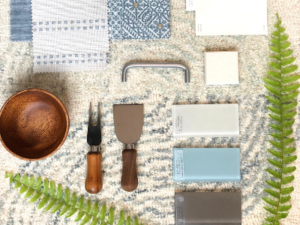5 Unexpected Costs You Might Forget in Your Home Renovation Project
September 29, 2021
No one likes surprises, especially when money is involved. The worst possible feeling when working on a home design project is realizing it’s going to cost more than you initially thought. You plan, plan, plan, and yet… that one thing you forgot to consider tips the scales of your project budget.
Hidden costs, or the logistic expenses that will most likely always be there but you may not always think about, are inevitable. They are simply part of the process. Those sneaky expenses are actually what make your project happen.
Being completely aware of the expenses you need to factor into your home design project will save you the headache in the end.
Below we dive into five hidden costs you may face during your project. To really study up on what you can expect from your realistic project expenses, download our FREE Timeline and Budget Guide!
1. Demolition and Disposal
If your design project will require some demolition - if you’re knocking down walls, ripping up floors, etc. - then you know you’ll need to hire a crew if you’re not DIY-ing the project.

When I work with a homeowner, the “hidden” costs of construction are covered in the overall construction cost we build into your budget. Out of sight, out of mind. But it’s important to know what those extra expenses are going toward and why they are necessary.
Building debris can pile up fast, and it will need someplace to go when you’re done. Research your municipality as you may need to buy a permit in order to pile up that debris. Then, you’ll most likely need to pay someone to dispose of that debris.
Basically, things are going to get loud and dusty in your home. A contractor will try to take care of the debris as much as possible and will most likely have their own plans for disposal in place.
But if you’re doing the demolition yourself, you should consider paying for a dumpster service. Either you can pay for a permit to temporarily put a dumpster in your driveway. Or you can pay for a service in which you’re sent large bags that can hold large quantities of debris. Then, you dispose of those bags as instructed.
There is some emotional cost in demolition as well. Since your home will be a cloud of dust for a while, you may be displaced and need to stay somewhere else. This is where the cost of child and pet care come in.
2. Child and Pet Care
Especially when renovating larger, highly used spaces in your home, remember that it is neither productive nor safe to allow children and pets to be present for these projects.

Not only will excess debris from demolitions be dangerous for your family to inhale, but it’s also convenient for no one - your family, your contractors, or yourself.
In my opinion, one of the most difficult transitions for a family during a home renovation involves frequently used spaces such as bathrooms and kitchens. These are spaces that often cannot be replaced and make living in the project space difficult for the whole family.
Don’t let this discourage you from renovating those spaces, though! The frequently used spaces are the most rewarding to redesign and renovate, both for families and for myself as the designer.
Consider alternate housing during the duration of your project, at least until you are able to safely return to your home even if your project is not yet complete. To save on this hidden cost, stay with relatives or friends and save up for a wonderful, much-deserved gift to present them by the end of it! Or, consider month-long stays at local Airbnb’s, which can be very cost effective.
If you don’t need to stay somewhere else altogether during your renovation project, I absolutely encourage you to crate your pets while workers are coming in and out of your home. At the very least, keep them confined to a separate room in the house. It is not a construction worker’s responsibility to keep Fluffy from running out the door as they carry heavy items in and out of your house. That is your responsibility.
Consider boarding your pet or having a friend look after them during the duration of your project, if that will relieve some stress on your end.
3. Storage of Existing Furniture
When you have beloved pieces you plan to incorporate in your newly designed home, those pieces have to stay somewhere while the project is completed.

Store these items off site for safe keeping. This avoids any risk of damage to those pieces and clears up space in your home, which will already be pretty cramped with the project underway.
In the case of needing to completely remove existing furniture - for instance, if you are renovating your floors - you can rent a pod for your driveway and then transport those items to a storage unit.
When your furniture is out of your house, then it’s out of the way. Your construction workers won’t have to move around those pieces or worry about them being damaged by debris, thus making them a lot happier. Happier workers equals higher productivity.
For those of you looking to save some change where you can: higher productivity means faster work, which means you save money.
4. Hardware, Hinges and Handles - Oh my!
When you’re finishing up your project, it really is all in the details. So, you really shouldn’t skip this part.
This is a classic example of hidden costs you may forget to consider:
In the excitement of picking out the perfect curtains, paint colors and cabinet style, you might calculate an inaccurate total if you forget to include the fixings that make those perfect choices function.
These extra costs can include drapery rods, curtain rings, door knobs, cabinet hardware, and the list goes on. Maybe these expenses seem minimal in the grand scheme of your project. After all, what is the cost of a door knob to demolishing an entire wall?
But the costs add up, and you’ll want to prepare for them when designing your budget.
5. Accessories and Artwork
Bare walls and bookshelves will keep your space looking unfinished. Your space is just four walls with fresh paint without accessories and artwork to truly make it yours.

Maybe you’ve collected some amazing pieces over the years that will finally fit your newly renovated home. Or maybe you need to refresh the creative side of your home with some new décor.
This isn’t cheap, and for some homeowners, this is the most tedious part of the process. I always suggest allocating at least 10% of the overall budget to décor. If you want to be safe, shoot for 10% to 15%. Although this may seem like a lot of money dedicated to aesthetics, it is exactly this part of the process that truly makes your home yours. This is what makes it special.
Here’s a bonus tip:
Bonus The hidden costs mentioned above are all inevitable and expected parts of the process. But that doesn’t mean there aren’t costs that arise that will catch you off guard. In designing a home, you should always expect the unexpected. Unforeseeable events, such as discovering vents where you were going to knock out a wall or realizing you need to upgrade your electrical foundations to match the new electronic accessories you purchased, might pop up from time to time. Only a psychic could truly prevent these hiccups, but only you can prevent the stress these surprises could put on you.
They’re Not So Hidden After All
When people hear “hidden costs,” they typically think, “OK, here comes a scam.”
Interior design is not a scam, and neither is renovating your home. It’s just complicated work that can take a toll on wallets and patience.
But when you work with a designer or contractor, they should always be transparent about these “hidden” costs. They know what comes with this type of work, so they should inform you of the reality every step of the way, especially at the start.
There are so many more costs to consider when building your budget for your home project. Our FREE Timeline and Budget Guide is a great first step in understanding the scope of cost and how long your project might take. Download the guide below!



